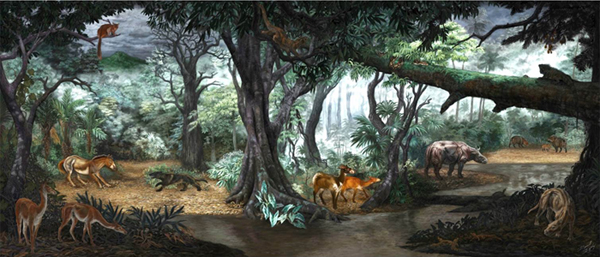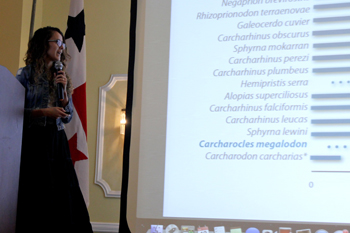By Dawn Mitchell | PCP PIRE and GABI RET Project Assistant
The impressive biodiversity of the modern-day Neotropics is widely known, but when and how this biodiversity came to be is not very well understood. The relative lack of well-exposed fossiliferous localities in Central America made answering questions about the emergence of Neotropical biodiversity difficult; however, excavations associated with the expansion of the Panama Canal revealed highly fossiliferous deposits. The clues that help solve the mysteries of the Neotropics seemed to come within reach.

As fossils and other geological evidence were collected, PCP PIRE researchers were able to paint a clearer picture of Panama’s geologic history and ancient biodiversity. Although there are too many discoveries to detail individually, some highlights include:
- The early Miocene Centenario Fauna, which contains a diverse assemblage of mammals from the uppermost Culebra and Cucaracha Formations, was recognized and temporally calibrated.
- Cetaceans and sirenians were added to the list of known members of the Miocene marine communities of the Neotropics.
- The giant shark Carcharocles megalodon, another member of the ancient Neotropical marine community, was studied extensively to understand the cause and effects of the extinction the apex predator.
- The first North American fossil monkey as well as the first fossil anthracothere and chalicothere in Central America were found in the early Miocene Las Cascadas Formation.
- A fossil gomphothere tooth collected from the shores of Lake Madden (now Lake Alajuela) in 1959 and brought to the attention of PCP PIRE in 2013 provided the first evidence of the existence of gomphotheres in Panama before the Pleistocene and had implications for the age of the Alajuela Formation.
- Fossil lianas told the tale of disturbances in the tropical forests of ancient Panama, and fossilized fruits gave us a glimpse of which trees constituted the Neotropical forests of the Eocene and Miocene.
- Analyses of geological and geochemical data yielded new information about changes to the environment tied to the closing of the Central American Seaway, including evidence that the seaway closed much earlier than previously thought.
- Detailed studies of the relationship between changing stratigraphy and faunal variation revealed the geologic history of the Gatun Formation and, correspondingly, provided clues for understanding the tectonic history of the Panama Canal Basin.
- A new species of ghost shrimp was described and named after the Panama Canal, and a fossil shrimp claw with beautiful muscle preservation was found at the Pacific entrance of the Panama Canal.

Several members of PCP PIRE have also been involved in efforts to better understand how to engage teachers, students, and the general public in STEM. GABI RET, an educational outgrowth of PCP PIRE, focuses on familiarizing K-12 science teachers with paleontological research. PCP PIRE also supported the development of a three-lesson curriculum concentrating on climate change and the evolution of horses in North America. The curriculum is currently in a testing phase to determine how well it works in practice.
Over the course of the program, PCP PIRE participants have published over 50 papers in peer-reviewed journals and have presented over 70 abstracts through poster and oral presentations at professional conferences. Numerous other research papers are in various stages of development, and there is the promise of many new scientific advances stemming from initial research done by PCP PIRE individuals. The many contributions made by PCP PIRE have significantly changed our understanding of the biological and geological history of the Neotropics and will continue to do so for years to come.
Por Dawn Mitchell | Ayudante de los proyectos PCP PIRE y GABI RET

La biodiversidad impresionante de las regiones neotropicales modernas es bien conocida, pero cuándo y cómo ésta diversidad llegó a ser no es bien entendido. La falta de lugares fosilíferos bien expuestos en Centroamérica complicó el busco para respuestas para las preguntas sobre la emergencia de la biodiversidad neotropical; sin embargo, las excavaciones asociadas con la expansión del canal de Panamá revelaron depósitos muy fosilíferos. Las pistas de solucionar los misterios de los neotrópicos estaban al alcance de nuestros investigadores.
Mientras recogíamos los fósiles y otra evidencia geológica, los investigadores de PCP PIRE llegaron a ser capaz de formar una visión más clara de la historia geológica y la biodiversidad antigua de Panamá. Aunque hay demasiados descubrimientos que detallar en éste artículo, aquí hay unos subrayas:
- La Fauna de Centenario del Mioceno temprano, la cual incluye mamíferos colectados en la parte superior de la formación Culebra y la formación Cucaracha, fue formalmente descrita y calibrada temporalmente.
- Los cetáceos y los sirenios fueron añadidos a la lista de miembros conocidos de las comunidades marinas miocenas de los neotrópicos.
- El tiburón gigántico Carcharocles megalodon, otro miembro de la comunidad marina neotropical antigua, fue estudiado extensivamente para entender las causas y los efectos de la extinción de éste depredador ápex.
- El primer mono norteamericano fosilizado, el primer antracotérido fosilizado y el primer fósil de un calicotérido fueron encontrados en la formación del Mioceno temprano de Las Cascadas.
- Un diente fosilizado de un gonfotérido colectado en las orillas del lago Madden (el lago Alajuela en actualidad) en 1959 que llegó a la atención de PCP PIRE en 2013 proveyó la primera evidencia de la existencia de gonfotéridos en Panamá antes del Pleistoceno, y tuvo implicaciones para la edad real de la formación Alajuela.
- Lianas fosilizadas mostraron los disturbios de las selvas tropicales de Panamá antigua, y frutas fosilizadas nos dieron una vista de cuales árboles constituyeron las selvas neotropicales del Eoceno y Mioceno.
- Análisis de las datas geologicales y geoquímicas produjo información nueva sobre los cambios del ambiente que son relacionados con el cerrar de la Vía Marítima Centroamericana, incluyendo evidencia que sugiere que el cerrar ocurriera más temprano que se suponía.
- Investigaciones detalladas de la relación entre estratigrafía cambiando y la variación de fauna revelaron la historia geológica de la formación Gatún, y proveyeron pistas de entender la historia tectónica del bacín del canal de Panamá.
- Una nueva especie de camarón fantasma fue descrito y nombrado en honor del canal de Panamá, y una garra de la dicha con sus músculos preservados perfectamente fue encontrado a la entrada Pacífica del canal.

Algunos miembros de PCP PIRE también han estado una parte de los esfuerzos de entender cómo incluir los maestros, los estudiantes y el público en STEM (ciencias, tecnología, ingeniera y matemáticas). GABI RET, una extensión de los programas de educación de PCP PIRE, se enfoca en familiarizar los maestros de ciencia de los grados K-12 con las investigaciones paleontológicas. PCP PIRE también apoyó el desarrollo de un programa de tres lecciones concentrando en el cambio del clima y la evolución de caballos en Norteamérica. El programa actualmente está en una fase de probar para determinar su eficaz.
Como parte de PCP PIRE, los participantes han publicado más de 50 investigaciones en revistas revisadas por expertos, y han presentado más de 70 abstractos por carteles y presentaciones orales en conferencias profesionales. Varias otras investigaciones están en desarrollo, y hay anticipación de muchas avances científicas con raíces en las investigaciones primeras por PCP PIRE. Las contribuciones de PCP PIRE han cambiado nuestro conocimiento de la historia biológica y geológica de los neotrópicos, y continuarán expandirlo en los años que vienen.